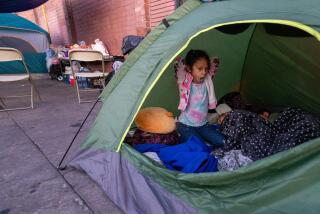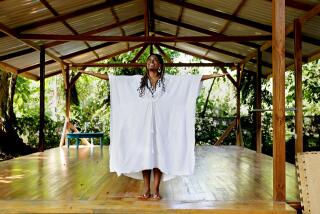O.C. Women Reach Out in Third World
- Share via
NAIROBI, Kenya — A trench with raw sewage runs down the center of the dirt path. Tin shacks and cardboard lean-tos line the streets. Children run barefoot through the filth, playing amid misery.
Goodby Orange County. Welcome to the Soweto slum of Nairobi.
Eight women from affluent enclaves such as Newport Beach and Irvine journeyed to Kenya for 15 days in July in an effort to reach out to women in slums and on farmland. It was a brutal exposure to the Third World, with its higher highs and lower lows, the sun somehow brighter, the shadows darker.
The eight belong to Women of Vision, an offshoot of World Vision, a Christian group founded in 1950 with the stated original purpose of helping Korean War orphans. World Vision, based in Monrovia, Calif., now has branched out to running humanitarian projects in 90 countries.
“In the Third World, there’s no power to the women,” except in rare cases, said Suzanne Paulson, a 55-year-old Laguna Beach resident who traveled to the Soweto slum of Nairobi last year and returned this year.
The Women of Vision group wanted to “empower” the women of Soweto, but not by a neocolonial imposition of American values or by telling the women what Orange County people thought was best for them.
“We have to work within their culture,” Paulson said. “That’s what we do.”
World Vision says that its goals in Nairobi include helping the women learn to sell home-grown vegetables by the side of the road; make furniture for sale; form cooperatives to farm; and provide education in health, sanitation and AIDS.
In a country where half the inhabitants are Christians, according to World Vision, the group says it also works to advance “the critical role of the church,” and there are frequent mentions in its literature of its proselytizing role.
Paulson says what drew her to the group “was establishing a long-term relationship with women in the Third World. That mission is being accomplished.”
Paulson lives in Emerald Bay in Laguna Beach and organizes art tours in the United States and abroad for museums and art groups, as well as publishing a quarterly newsletter dealing with art travel.
Paulson said that on her art tours, she gets into the homes of the rich and famous, but “I never get to meet the ‘real people.’ ”
The Orange County women spent two days visiting Soweto--spending the night in a Nairobi hotel--and then visited two of their other projects during their trip.
When friends of hers set up Women of Vision in Orange County three years ago, she was happy to join. The trips to Africa last year and this have made “a tremendous change in my life.”
But she conceded that the Soweto slum in Nairobi, the Kenyan capital, took some getting used to.
On her first visit last year, “we drove around on a dank, dreary cold day,” Paulson remembered. “We were looking for the man who was in charge and I was (saying to myself), ‘Oh, please, let’s not find him.’ I’d seen enough.”
But they found the supervisor and Paulson continued on, walking through the slum. Two women who lived there, aged 29 and 30--about the age of Paulson’s daughters--came up to her and warned her to beware of thieves and hold on to her belongings. They helped escort her through the streets and “became my friends,” Paulson said.
Soweto is a slum without clean water, without electricity, without plumbing. Those who live here--about 18,000 in all--are by and large illiterate, unemployed and poor. Nearly all live in conditions so squalid and mean that crime is guaranteed to flourish, as people steal to live.
Even for those living in the better sections of Nairobi, security has become an increasing concern in recent years. Most residents have an armed guard on duty around the clock; locked gates bar the entrance to most properties. Sophisticated alarm systems, iron bars on windows and doors are also much in evidence.
Paulson said there wasn’t any project in the slum last year, so the Women of Vision told their contacts in Soweto to find a specific cause, then returned to Orange County to start raising funds for the slum and for other projects.
After a year and nearly $200,000 raised, the group that returned this year was able to kick in the money for salaries for three community organizers and a coordinator, plus pay for training for other workers. Total: $24,694.
“When you left us last year we didn’t know what cleanliness was,” said one woman who spoke to the Women of Vision. Now, “we set every Saturday aside for cleaning the village.”
Patti Johnson, a co-founder of Women of Vision who is in her mid-40s, said that despite the poverty, Soweto women enjoyed singing, clapping and dancing.
“In the midst of cardboard makeshift homes, walkways cluttered with sewage, runny-nosed little African children greeting you with the only English they know--’How are you?’--filth, dirt and tattered clothes, they were welcoming us, “ said Johnson, an Irvine resident. “Their poverty, their love, their joy, their dignity, and their courage empowered us. “
Johnson said the trip to Kenya again hammered home the impression that African women are confronted by “unrelenting work.” One study estimated that women work twice as many hours each day, 15 to 18, as men, but earn only one-tenth the pay. They sometimes must walk five miles to fetch water. They have little access to credit and often have no opportunity to own land.
The Women of Vision worked with 13 different groups of African woman, with about 20 in each group, during their stay. The American women all noticed how much of the daily work needed just to keep things going is done by the women of Africa. Men run the families and control the finances, but women do most of the manual labor, from child rearing and farming to cooking and building.
But Johnson said she was also amazed by the resourcefulness of the women living in slums.
“They would take a root that looked like a giant-sized piece of celery,” Johnson said. “After scraping this root with a knife, the fibrous strings are then dried out to be used as thread or yarn. We all stood in awe at their resourcefulness in creating the color purple. They just boiled some carbon paper in an empty coffee container. This process created a purple dye. The fibrous twine was then immersed in the purple dye. . . . Purple twine could now be used in sewing bags.”
World Vision says that more than half of Nairobi’s 2-million-plus people live in slums. As drought devastates farmland, the men migrate to the cities, looking for any kind of job but usually without the skills needed for steady employment. Homes are quickly thrown together, and are often just cardboard shacks.
“You know that those people are never going to get out of the slums,” Paulson said. “The only hope is that you’re going to make their lives better, living there. You can pray that they’re going to get out of there, but I don’t know how.”
And yet, Paulson says, “when you walk in the streets of Nairobi and you see the beggars and you see the homeless, Soweto almost looks good,” Paulson said. And compared to neighboring countries like Ethiopia and Somalia, the former British colony that was led to independence by Jomo Kenyatta after the Mau Mau rebellion of the 1950s is better off.
Still, the poverty is incredible. “Although trenches had been dug for the urine streams,” Paulson wrote in a summary of her trip, “in all honesty, I can not say the physical appearance of Soweto had changed much since last year.”
But she said the women of Soweto felt they had made progress and wanted to make more. “Their faith was infectious.”
And the bottom line for Paulson is, she’ll go back next year.
Times staff writer John Needham contributed to this story.
More to Read
Sign up for Essential California
The most important California stories and recommendations in your inbox every morning.
You may occasionally receive promotional content from the Los Angeles Times.










